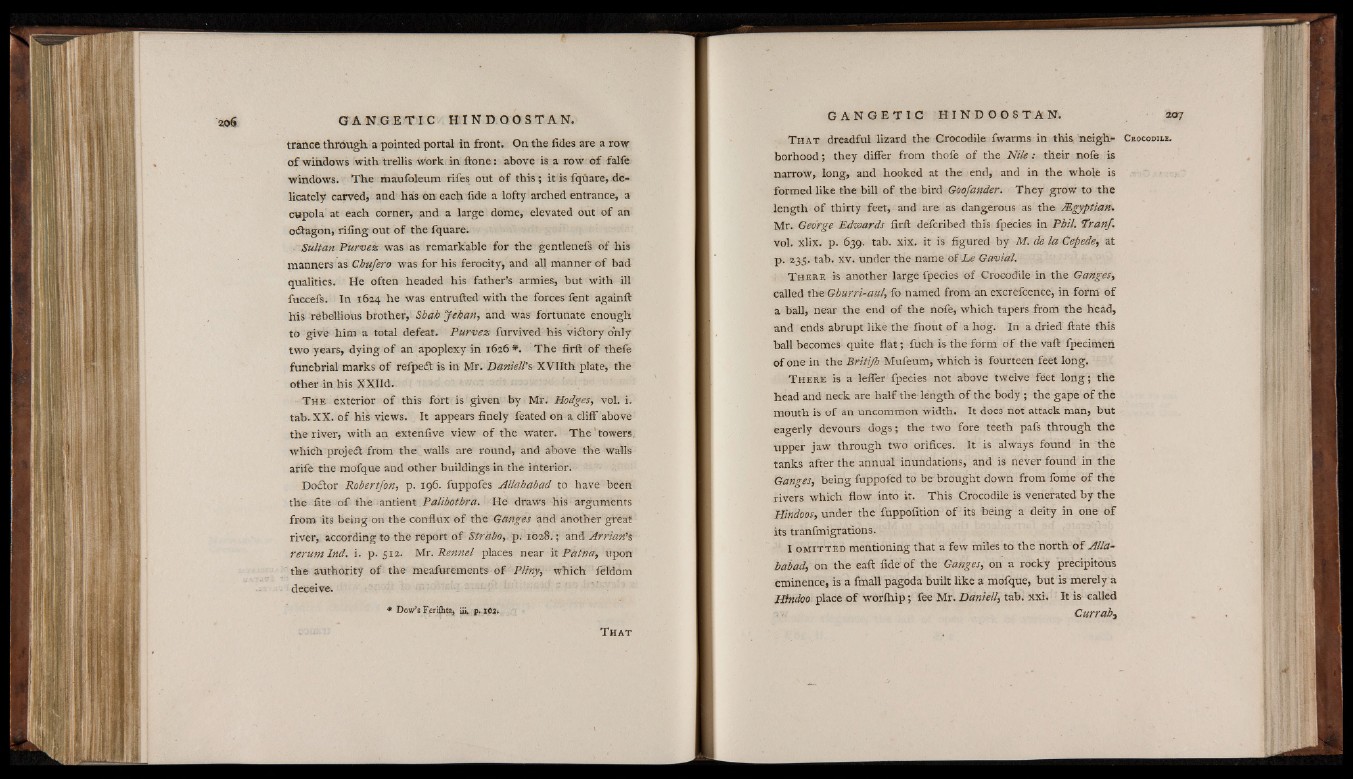
trance through a pointed portal in front. On the fides are a row
o f windows with trellis work in ftone: above is a row o f falfe
windows. The maufoleum rifes out Of this; it is fquare, delicately
carved, and has on each fide a lofty arched entrance, a
cupola at each corner, and a large dome, elevated out of an
o&agon, riling out o f the fquare.
Sultan Purvez was as remarkable for the gentlenefs of his
manners as Cbufero was for his ferocity, and all manner of bad
qualities. He often headed his father’s armies, but with ill
fuccefs. In 1624 he was entrufted with the forces lent againft
his rebellious brother, Shah Jeban, and was fortunate enough
to give him a total defeat. Purvez furvived his viitory only
two years, dying o f an apoplexy in 1626 *. The firlt of thefe
funebrial marks of refpeft is in Mr. Daniel/’s XVIIth plate, the
other in his XXIId.
T h e exterior o f this fort is given by Mr. Hodges, vol. i.
tab. XX. of his views. It appears finely feated on a cliff above
the river, with an extenfive view o f the Water. The'towers,
which projeit from the walls are round, and above the walls
arife the mofque and other buildings in the interior.
Do£tor Robertfon, p. 196. fuppofes Allababad to have been
the fite o f the-antient Palibothra. He draws his arguments
from, its being on the conflux o f the Ganges and another great
river, according to the report of Strabo,. p. 1028.; and Arrian's,
rerum Ind. i. p. 512. Mr. Rennel places near it Patna, upon
the authority o f the meafurements of P/my, which feldom
deceive.
* Dow’s Feriihta* iii. p. 102»
T h a t dreadful lizard the Crocodile fwarms in this neighborhood
; they differ from thofe of the N ile: their nofe is
narrow, long, and hooked at the end, and in the whole is
formed like the bill of the bird Goofattder. They grow to the
length of thirty feet, and are as dangerous as the Mgyptian.
Mr. George Edwards firlt defcribed this fpecies in Phil. Tranf.
vol. xlix. p. 639. tab. xix. it is figured by M. de la Cepede, at
p. 235. tab. xv. under the name of Le Gavial.
T h e r e is another large fpecies of Crocodile in the Ganges,
called the Ghurri-aul, fo named from an excrefcenee, in form of
a ball, near the end o f the nofe, which tapers from the head,
and ends abrupt like the fnout o f a hog. In a dried itate this
ball becomes quite flat; fueh is the form o f the vaft fpecimeii
of one in the Britijh Mufeum, which is fourteen feet long.
T h e r e is a lelfer fpecies not above twelve feet long ; the
head and neck are half the length of the body ; the gape of the
mouth is of an uncommon width. It does not attack man, but
eagerly devours dogs; the two fore teeth pafs through the
upper jaw through two orifices. It is always found in the
tanks after the annual inundations, and is never found in the
Ganges, being fuppofed to be brought down from fome of the
rivers which flow into it. This Crocodile is venerated by the
Hindoos, under the fuppofition of its being a deity in one o f
its tranfmigrations.
I o m i t t e d m e n t io n in g th a t a f e w m i le s t o t h e n o r t h o f Allahabad,
o n t h e e a f t f id e o f t h e Ganges, o n a r o c k y p r e c ip i t o u s
em in e n c e , is a im a l l p a g o d a b u i l t l i k e a m o fq u e , b u t is m e r e ly a
Hindoo p la c e o f w o r l h i p ; fee Mr. Daniell, t a b . x x i . It is c a lle d
Currab>
C rocodile.